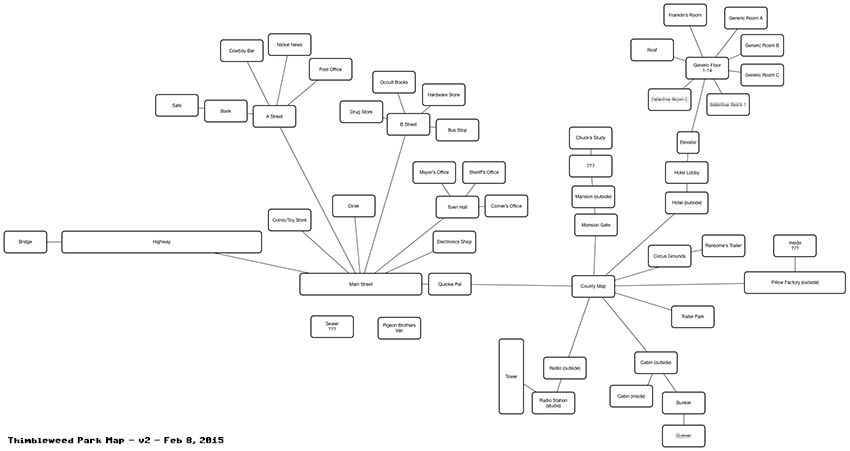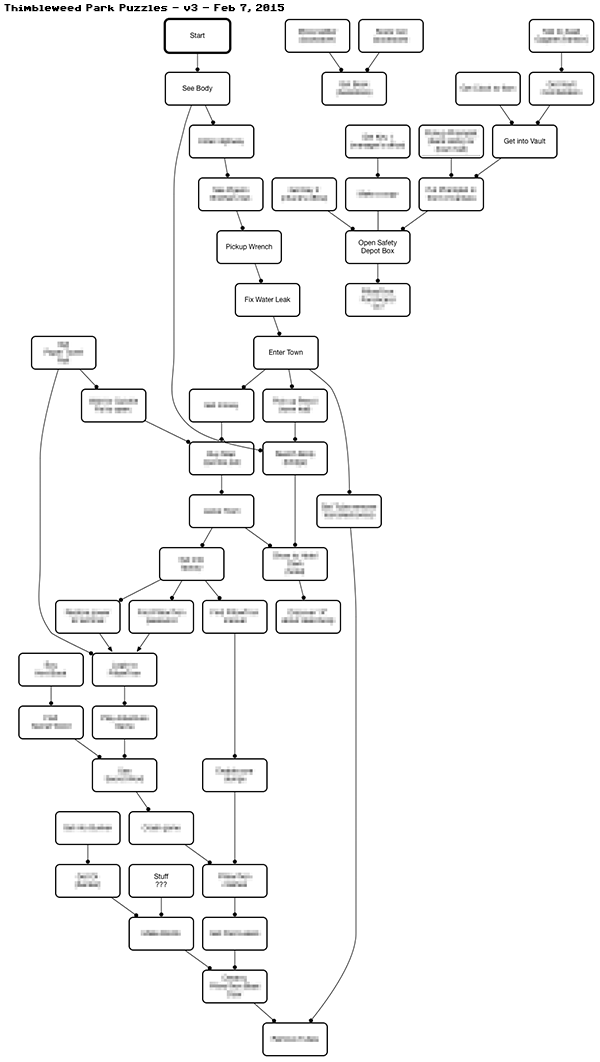Maps and Puzzles
Feb 09, 2015
I spent much of last week working on the Thimbleweed Park design, so not a lot happened in the code. Gary and I spent the time putting together the map of the world showing all the locations, or "rooms" as we call them.
I'm not sure why the term "room" crept into my lexicon for describing locations in adventure games. I don't know if it was because Maniac Mansion took place in the mansion, so it was natural to describe them as rooms, or if the term originated in early text adventures. SCUMM called them rooms and many of the commands used that word and it's just stuck.
As we've been putting together the puzzles and story, Gary and I have been keeping a big list of all the rooms in the game, but last week we finally put them together in map and starting making all the connections. Having a list of rooms is one thing, but when you see them all connected together, your brain (or at least mine) can start building an image of the world. Seeing them all connected together also points out problems with bunching or choke points.
An adventure game world should open up like an onion (well, an inside-out onion). As players solve puzzles they get access to more and more of the ever expanding world. It's good for dramatic reasons, but also helps with focus and making sure they aren't overwhelmed with too many choices too early.
Maniac Mansion had 36 explorable rooms, plus another 5 or 6 rooms for things like the title screen or the talk show set. Monkey Island had around 70 explorable rooms and another 15 or so close-ups, title screens, etc.
We've always thought about Thimbleweed Park being Monkey Island size in terms of the world, so we're shooting for 100 rooms and will probably come in at around 80 or 90. It's hard to tell at this stage. With Maniac Mansion and Monkey island, disk space was our number one limiter of size and with Thimbleweed Park, that's close to a non-issue. Our limiting factor will be the work involved in drawing and implement the rooms.
The map below includes all the major locations, and some will grow by 5 or 6 rooms. For example, Delores' Mansion is 3 rooms on the map, but it will end up being closer to 8 or 10. The pillow factory is another that will expand dramatically, as well as the circus and the hotel.
Now that we have a map, we'll start the process of adding, removing and editing. Some of these rooms won't make it into the final game because they'll end up being redundant, uninteresting, or the puzzle required for their existence was cut.
Please note: as with anything you see on this dev blog, don't become to attached.
It's also important to remember that these "rooms" scroll, so they can be, and often are, more than one screen wide.

We've also done a few passes on the puzzle dependency chart. This is far from done, so it represents maybe 25% of the game. There are several disconnected nodes that will get hooked up as we figure out bridging puzzles and that will change the look and flow quite a bit over the next few weeks.

Enjoy! My plan for next week is to have the core UI working, including verbs, and probably room transitions, and Gary's plan is more concept art while we both noodle away at puzzles.

I remember being 7 years old and being able to stare at the MI1 and 2 maps for hours, imagining what would be in those non-clickable locations. Good stuff and thanks for the updates. They're much appreciated.
There is really a lot to be said for keeping things simple and flexible.
I think this is a hangover from my Flash days... But I also really like the Movie/Stage analogy when working on games. Makes everything a little more tangible. Actor is so much nicer than RenderableEntity, y'know?
That said, I sure hope you won't give away too many details. The last thing I want is to get my hands on the finished game in a year and a half, and there's nothing left to discover for me because I know everything from the blog. Then again, I am sure you guys are way too experienced to allow this to happen.
Keep up the good work!
I still remember the living room? bedroom? in the theater where Indiana Jones meets Sophia Hapgood.
And Chuck the plant was there too!
https://tcrf.net/Indiana_Jones_and_the_Fate_of_Atlantis#Sophia_Hapgood.27s_Office
One question: Do you guys plan on having Thimbleweed Park feature any type of fast-travel system on the map screen for areas already accessible for a specific character when that character is standing outside? For example if you have already accessed both the circus tent and post office for Detective A, could Detective A standing from outside the Cowboy Bar "warp"to the outside of the circus tent from the map screen or would she have to walk (or drive...?) the entire distance? Or... would it ruin and prevent important "room" to "room" events from happening that are absolutely necessary for how the game plays. Or... are there taxis or can you steal the pigeon brother's van or anything like that (well if so i guess that'd be a spoiler so don't answer that, that's just me completely guessing lol).
A fast-travel system in Maniac Mansion for example is something that obviously and absolutely would've been completely inappropriate and unworkable, not just because nearly the entire game took place inside of the mansion but as you went from room to room you could get caught, certain cutscenes would occur, you had a "hidden" time limit to do certain things such as to pick up the mail package at the front door, etc. etc.
I know that everything is still a work in progress and also you don't want to reveal spoilers so if you have to stay mum on this that's cool with me =)
A "Room" which has nothing to do with the main game, but is just for fun maybe with some goofs or misleading hints.
All players like to find some hidden easter eggs, so why not give them a few :)
Out of interest - did the ~70 rooms in Monkey Island include the randomly occurring rooms in Melee Forest and the Monkey Head catacombs? Do you recall how many there actually were? Or were they actually not random at all? (If not, then my mind has officially been blown!)
DOTT replaced that with a very different (time traveling) twist, but naturally in that game you weren't supposed to be intruders into the Edison mansion, but were helping Dr. Fred to save the World from Tentacle Invasion. Monkey 2 in that regard was equally much more conventional, but unlike standard adventure tropes still gave a very good impression that Le Ch. might actually be out to get you (even though he never did) by all the breaks that occurred and triggered cut scenes in his fortress revealing the plans to the player. By MI2, those were scripted and were triggered by finding map pieces in Chapter 2. In Maniac Mansion, this equally was pseudo real-time (I think one of the first actions of the NPC cast was Weird Ed going to fetch the cheese from the fridge -- if it was still there that is.).
Seckrit Question was wrong! Please try again!
Are those graphs drawn manually, or did you use a tool?
As flowcharts like those tend to be of use for any gaming project (with storylines and quests/riddles), not just adventure games, I'd love to learn which one you use.
> My plan for next week is to have the core UI working, including verbs, and probably room transitions
Ah, looking forward to some video :-)
> Gary's plan is more concept art
Can't wait to see more Gary-style pixel-art
> while we both noodle away at puzzles
why not puzzle away at noodles? (fancy a noodle puzzle?)
Thanks for the frequent updates! Luv them!
Keep up the excellent work with the developer's diary and indeed with the game - I'm very much looking forward to it!
http://www.mrbillsadventureland.com/reviews/m-n/monkeyR/cannonfire1.jpg
http://digilander.iol.it/MonkeyIslandforever/L%27allibratore.jpg
*grind him
(Sorry but I was writing in English with an Italian grammar checker)
There is infamous saying "Design by committee" and I don't think adventure game puzzles can benefit from it either. So feedback on your puzzle chart would be useless.